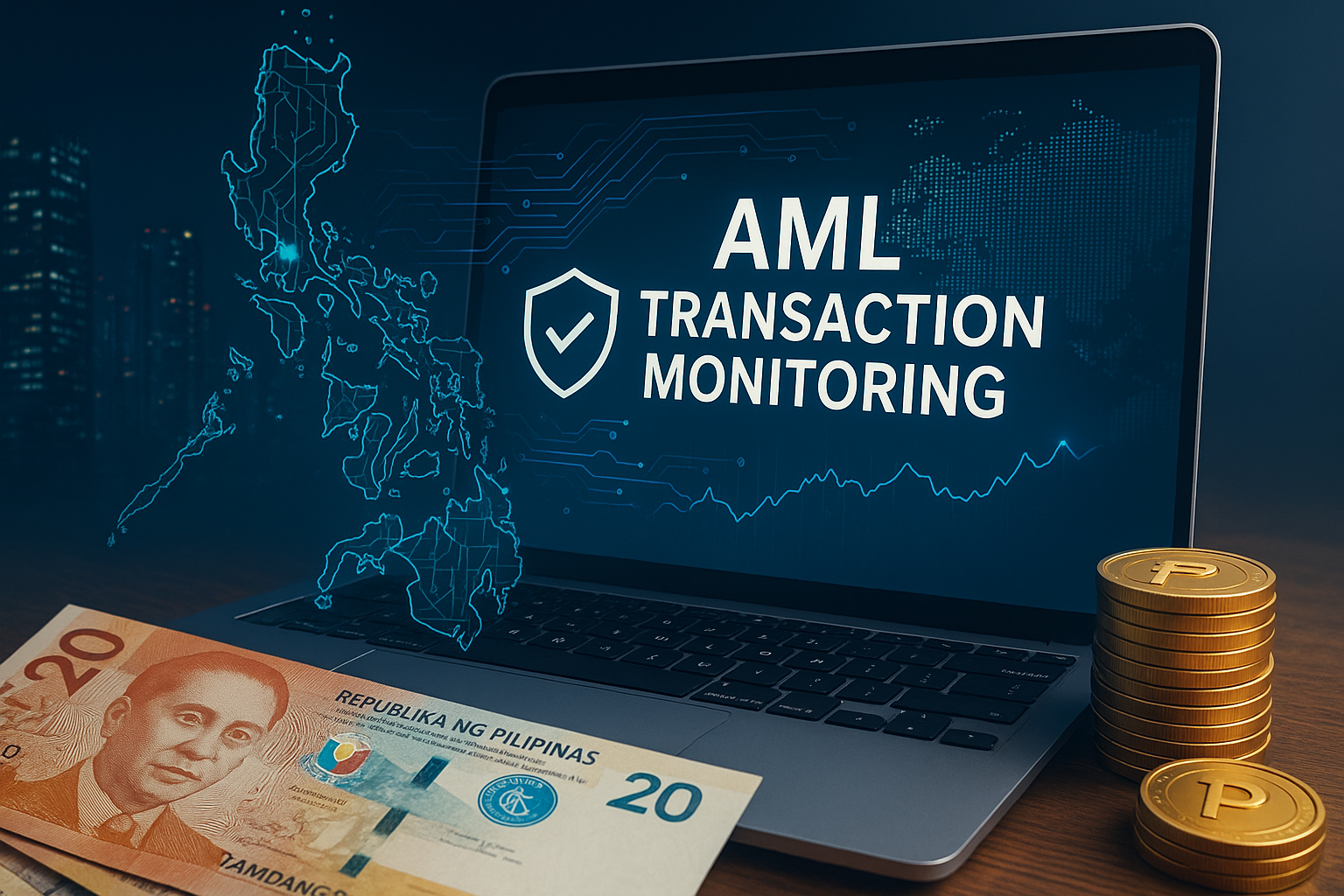Watching Every Move: How Smart AML Transaction Monitoring is Reinventing Compliance in the Philippines
.svg)
In the Philippines’ fast-changing financial system, staying ahead of money launderers means thinking faster and smarter than ever before.
The Philippines has rapidly evolved into one of Southeast Asia’s most dynamic financial markets. Digital payments, e-wallets, and online remittance platforms have transformed how money moves. But they’ve also created fertile ground for criminals to exploit loopholes and move illicit funds at unprecedented speed.
The result? A new era of financial crime that demands a new kind of vigilance. Traditional compliance systems, built on static rules and manual intervention — can no longer keep up. To detect, prevent, and respond to suspicious activity in real time, financial institutions in the Philippines are turning to AML transaction monitoring software powered by Agentic AI.
This isn’t just an upgrade in technology — it’s a complete reinvention of how compliance works.

The Evolving AML Landscape in the Philippines
Over the past decade, the Philippines has strengthened its anti-money laundering (AML) framework under the guidance of the Anti-Money Laundering Council (AMLC) and the Bangko Sentral ng Pilipinas (BSP). Both regulators have introduced data-driven, risk-based supervision that demands faster suspicious transaction reporting (STRs) and more proactive monitoring.
Yet, challenges remain. The country continues to face money-laundering threats tied to predicate crimes such as:
- Investment and crypto scams
- Online gambling and cyber fraud
- Terrorism financing through cross-border remittance
- Organised mule networks moving small-value transactions in bulk
The FATF’s ongoing scrutiny of the Philippines has added further urgency for compliance transformation. Local banks and fintechs are now expected to show measurable improvements in real-time detection, reporting accuracy, and data transparency.
For compliance leaders, this isn’t simply about meeting regulations. It’s about restoring trust — building a financial system that citizens, partners, and regulators can rely on.
What AML Transaction Monitoring Really Means
At its core, AML transaction monitoring refers to the continuous analysis of financial transactions to detect patterns that could indicate money laundering, fraud, or other suspicious activity.
Unlike static rules engines, modern systems learn from data. They evaluate not just whether a transaction breaks a threshold — but whether it makes sense given a customer’s behaviour, network, and risk profile.
A modern AML monitoring system typically performs four key tasks:
- Data Integration: Collects and consolidates customer, account, and transaction data from multiple systems.
- Pattern Detection: Analyses transaction sequences to flag anomalies — such as rapid fund transfers, unusual remittance corridors, or inconsistent counterparties.
- Alert Generation: Flags high-risk transactions and assigns risk scores based on behavioural analytics.
- Case Management: Escalates suspicious activity to investigators with contextual evidence.
But what separates smart AML systems from the rest is their ability to adapt — to learn from investigator feedback, detect unseen typologies, and evolve with each new risk.
The Challenge for Philippine Financial Institutions
While most major Philippine banks have some form of automated transaction monitoring, several pain points persist:
- High false positives: Legacy systems trigger excessive alerts for legitimate activity, overwhelming investigators.
- Fragmented data: Disconnected payment, lending, and remittance systems make it difficult to see the full picture.
- Limited investigative capacity: Compliance teams often face resource constraints and manual processes.
- Regulatory pressure: AMLC and BSP expect near real-time STR submissions and audit-ready documentation.
- Emerging typologies: From synthetic identities to mule rings and crypto crossovers, criminals constantly evolve their methods.
To meet these challenges, financial institutions need intelligent AML transaction monitoring — systems that can reason, learn, and explain.
Enter Agentic AI: The Brain of Modern Transaction Monitoring
Traditional AI systems detect patterns. Agentic AI, however, understands purpose. It can analyse intent, connect context, and take autonomous actions to assist investigators.
In the world of AML transaction monitoring, Agentic AI brings three major shifts:
- Contextual Awareness: It understands the “why” behind each transaction, identifying behavioural deviations that static models would miss.
- Dynamic Adaptation: It adjusts to emerging risks in real time, learning from each investigation outcome.
- Interactive Collaboration: Investigators can communicate with the AI using natural language — asking questions, exploring relationships, and receiving guided insights.
This makes Agentic AI the missing link between raw data and human judgment. Instead of replacing analysts, it amplifies their intelligence, handling repetitive tasks and surfacing critical insights at lightning speed.
Tookitaki FinCense: Agentic AI in Action
At the forefront of this evolution is Tookitaki’s FinCense, an end-to-end compliance platform designed to build the Trust Layer for financial institutions.
FinCense combines Agentic AI, federated learning, and collective intelligence to power smarter, explainable, and regulator-ready AML transaction monitoring.
Key Capabilities of FinCense
- Adaptive Risk Models: Continuously refine detection logic based on feedback from investigators.
- Real-Time Detection: Identify abnormal patterns within milliseconds across high-volume payment systems.
- Federated Learning: Enable cross-institutional intelligence sharing without compromising data privacy.
- Scenario-Driven Insights: Leverage typologies and red flags contributed by the AFC Ecosystem to detect emerging threats.
- Explainability: Every decision and alert can be traced back to its logic, ensuring full transparency for auditors and regulators.
FinCense helps Philippine banks transition from reactive monitoring to predictive compliance — detecting risk before it materialises.
Agentic AI Meets Human Expertise: FinMate, the Copilot for Investigators
Monitoring is only half the battle. Once alerts are raised, investigators need to understand context, trace transactions, and document findings. This is where FinMate, Tookitaki’s Agentic AI-powered investigation copilot, steps in.
FinMate acts as a virtual assistant that supports analysts during investigations by:
- Summarising alert histories and previous cases.
- Suggesting possible linkages across accounts, networks, or jurisdictions.
- Drafting narrative summaries for internal and regulatory reporting.
- Learning from investigator corrections to improve future recommendations.
For compliance teams in the Philippines — where staff often juggle high alert volumes and tight deadlines — FinMate helps turn hours of analysis into minutes of decision-making. Together, FinCense and FinMate form an intelligent ecosystem that makes transaction monitoring not just faster, but smarter and fairer.
Core Features of Next-Gen AML Transaction Monitoring
The future of AML transaction monitoring is defined by five core principles that every institution in the Philippines should look for:
1. Dynamic Risk Scoring
Customer risk is no longer static. Modern systems assess behaviour in real time, considering peer groups, network exposure, and transaction context to continuously recalibrate risk scores.
2. Federated Learning for Privacy and Collaboration
Instead of sharing sensitive data, institutions using FinCense participate in federated model training. This allows collective learning from typologies seen across multiple banks — without exposing customer information.
3. Scenario-Based Detection from the AFC Ecosystem
The AFC Ecosystem contributes thousands of expert-curated scenarios and red flags from across Asia. When integrated into FinCense, these scenarios help Philippine banks recognise typologies early — from fraudulent lending apps to cross-border mule pipelines.
4. Explainable AI for Regulatory Confidence
Every alert and score must be defensible. FinCense offers clear audit trails and interpretable AI outputs so regulators can verify how a decision was made — strengthening transparency and accountability.
5. Agentic AI Copilot for Decision Support
FinMate transforms the analyst experience by providing context-aware recommendations, case summaries, and guidance in plain language. It helps investigators focus on judgment rather than data retrieval.

Building a Collaborative Defence: The AFC Ecosystem
While AI technology drives efficiency, collaboration drives resilience.
The AFC Ecosystem, powered by Tookitaki, is a community of AML and fraud experts who contribute real-world typologies, scenarios, and red-flag indicators. These insights are continuously fed into systems like FinCense, enriching transaction monitoring with intelligence gathered from live cases across the region.
Why It Matters for the Philippines
- Cross-border typologies like remittance layering or online gambling proceeds are often first detected in neighbouring markets.
- Shared insights allow Philippine banks to update detection logic pre-emptively, rather than after exposure.
- Compliance teams gain access to Federated Insight Cards, summarising trends and risks from collective learning.
This model of community-powered compliance ensures the Philippines is not only compliant — but one step ahead of evolving financial crime threats.
Case in Focus: Transforming AML Monitoring for a Leading Philippine Bank and Wallet Provider
A leading Philippine financial institution recently partnered with Tookitaki to replace its traditional FICO system with FinCense Transaction Monitoring. The goal: to improve accuracy, reduce false positives, and accelerate compliance agility.
The results were remarkable. Within months of deployment, the bank achieved:
- >90% reduction in false positives
- 10x faster deployment of new scenarios, improving regulatory readiness
- >95% accuracy and higher alert quality
- >75% reduction in alert volume, while processing 1 billion transactions and screening over 40 million customers
These outcomes were powered by FinCense’s intelligent risk models and the AFC Ecosystem’s continuously updated typologies.
Tookitaki’s consultants also played a crucial role — helping the client prioritise regulatory features, train internal teams, and resolve technical gaps. The collaboration demonstrated that the combination of AI innovation and expert enablement can fundamentally transform compliance operations in the Philippines.
From Detection to Prevention: The Road Ahead
The evolution of AML transaction monitoring in the Philippines is shifting from detection-centric to prevention-oriented. With real-time data streams, open banking integrations, and cross-border digital rails, the lines between fraud, AML, and cybersecurity are blurring.
The Next Frontier
- Predictive Monitoring: Using behavioural modelling and external intelligence feeds to forecast potential laundering attempts.
- AI Governance: Embedding ethical, explainable frameworks that satisfy both regulators and internal stakeholders.
- Regulator-Industry Collaboration: AMLC and BSP’s future initiatives may emphasise data interoperability and collective intelligence for ecosystem-wide risk mitigation.
As these changes unfold, Agentic AI will play a critical role — serving as the analytical bridge between human intuition and machine precision.
Conclusion: Smarter Monitoring for a Smarter Future
The Philippines stands at a defining moment in its financial compliance journey. With evolving threats, tighter regulation, and fast-moving digital ecosystems, the success of AML programmes now depends on intelligence — not just rules.
AML transaction monitoring software, powered by Agentic AI, is the new engine driving this transformation. Through Tookitaki’s FinCense and FinMate, Philippine financial institutions can move beyond reactive compliance to proactive prevention — reducing risk, building trust, and strengthening the country’s position as a credible financial hub in Asia.
The message is clear: in the fight against financial crime, those who collaborate and innovate will always stay one step ahead.
Experience the most intelligent AML and fraud prevention platform
Experience the most intelligent AML and fraud prevention platform
Experience the most intelligent AML and fraud prevention platform
Top AML Scenarios in ASEAN

The Role of AML Software in Compliance

The Role of AML Software in Compliance









